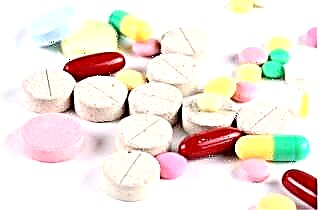Cough is not an independent disease. This is just a symptom indicating the development of certain ailments in the body. Antibiotics for coughing in adults are prescribed to eliminate the cause that triggered their occurrence.
Treatment of a cough with antibiotics for a common cold is completely inappropriate. Respiratory diseases can be successfully treated with antipyretic drugs, as well as preparations based on medicinal herbs. It is permissible to take an antibiotic for coughing if the symptoms of the disease could be caused by mycoplasmas or chlamydia. The antibiotic for cough, which occurs with ARVI and influenza, is not used, since it is not able to affect viruses.
When to treat a cough with antibiotics
For the treatment to be correct and, accordingly, effective, you need to know how a viral disease differs from a bacterial one. Indeed, completely different drugs are used to eliminate infectious agents of both types.
Signs of a viral infection:
 runny nose with clear and runny snot (feeling that "flows like from a tap");
runny nose with clear and runny snot (feeling that "flows like from a tap");- cough (both wet and dry) - it can also produce phlegm, which often flows down the larynx.
As already mentioned, if the disease is acutely infectious (for example, respiratory or flu), antibiotics are strictly prohibited. Since the culprit of the disease is a virus, and it must be treated with any of the effective antiviral drugs. It is logical that antibacterial medicines cannot fight viruses in any way. Their target is bacteria.
Bacterial infection is characterized by thick sputum, which accumulates not only in the upper, but also in the lower respiratory tract. The sputum has a greenish or yellowish color, there may be impurities of pus. A bacterial infection can be suspected by a high temperature, which persists for 3 days, a prolonged course of the disease, shortness of breath and a high content of leukocytes in the blood.
It should be noted that harmful bacteria are rarely the cause of primary infection. A bacterial infection often joins a viral infection against the background of a general decrease in the body's resistance.
This happens when:
- SARS and flu;
- colds (ARI);
- weakening of the protective functions of the body after surgery, some infections or allergies.
We emphasize once again that antibacterial drugs are effective exclusively against cough of a bacterial nature. For example, antibiotics for coughs should be taken when:
- acute and purulent tracheitis;
- bacterial bronchitis;
- pneumonia;
- pleurisy;
- tuberculosis.
Taking antibacterial drugs should be strictly targeted. If you use such drugs without a prescription and a clear diagnosis, they can provoke a significant exacerbation of the disease and the development of complications.
List of drugs for adults
When, after passing the tests, it was found that the cough is of bacterial origin, the doctor will prescribe a course of treatment with antibacterial agents. Here is a list of drugs that are most often prescribed for adults today.
 "Summamed" (active substance - azalide). Belongs to the category of macrolides. Possesses a wide spectrum of action - it is detrimental to a large number of harmful bacteria.
"Summamed" (active substance - azalide). Belongs to the category of macrolides. Possesses a wide spectrum of action - it is detrimental to a large number of harmful bacteria.- "Azithromycin" (active ingredient - the same name). A drug from the macrolide group. Available in the form of tablets or capsules. It differs from other antibiotics in that it has a milder effect on the gastrointestinal tract.
- "Macropen" (the main substance is midecamycin). Macrolide, which is prescribed to eliminate severe cough.
- "Ampicillin" (active substance of the same name). Belongs to the category of penicillins. Effectiveness has been tested and proven over time. It has been successfully used for several generations of patients. The main disadvantage of the drug is a fairly high level of resistance.
- "Ampiox" (active ingredients - oxacillin and ampicillin). A medication from the penicillin group. It is prescribed to treat inflammation affecting the upper respiratory tract. It is characterized by a high level of resistance, however, like many penicillins.
- "Augmentin" (the main substances are clavulanic acid, amoxicillin). Another penicillin antibiotic. This drug is recommended for the treatment of a large number of diseases of bacterial origin - laryngitis, tracheitis, bronchitis and pneumonia.
- "Suprax" (active substance - cefixime). Belongs to the category of cephalosporins. Medication of the third generation. Quickly removes symptoms of respiratory diseases and effectively fights bacteria.
- "Ceftriaxone" (the active ingredient is of the same name). The drug is of the cephalosporin group. Most often, this medicine is prescribed for severe bronchitis and pneumonia, which are accompanied by a severe cough. This medication is intended for injection only. The doctor gives individual recommendations on how to inject Ceftriaxone - intramuscularly or intravenously.
 "Amoxiclav" (the main substances are clavulanic acid and amoxicillin). This antibiotic has a broad spectrum of action. It is prescribed for bacterial laryngitis, laryngotracheitis, bronchitis and pneumonia. Acts quickly enough. In fact, it is analogous to "Augmentin".
"Amoxiclav" (the main substances are clavulanic acid and amoxicillin). This antibiotic has a broad spectrum of action. It is prescribed for bacterial laryngitis, laryngotracheitis, bronchitis and pneumonia. Acts quickly enough. In fact, it is analogous to "Augmentin".
For adults, antibiotics are usually given in tablets (capsules). If necessary, they can be administered by injection. For children, special forms are provided - suspensions (powders) or syrups. Of course, an adult can also purchase the drug in a "child" form if it is uncomfortable to swallow tablets or capsules. However, in this case, you need to carefully observe the dosage - if it is calculated for the child, the medicine simply will not work.
Among these forms of release of antibacterial drugs, the most often prescribed is the "Summamed" suspension and the "Ospin" syrup (from penicillins). If the cough is very severe, it is better to prefer these forms of drugs, so as not to accidentally choke.
How to take it right
The selection of an antibiotic must be competent and always individual. Even if you have found all the symptoms of a bacterial infection in yourself, you still need to take sputum for analysis. Such a study identifies a specific pathogen, and at the same time checks how sensitive it is to antibacterial drugs. Having received the results of the culture, the doctor will accurately determine the cough and the type of antibiotic that will cope with the disease in this case.
The algorithm for detecting a bacterial infection is extremely simple. However, it happens that the patient's condition deteriorates very quickly. There is simply no time to wait for the analysis results. Then the doctor prescribes antibiotics empirically - trying options. One of them will definitely work, and the patient will need to take it as a course.
Antibacterial drugs must be taken at the same time. Due to the observance of such punctuality, a concentration of active substances will be created in the blood, which will be enough for the early death of harmful bacteria. If you ignore the recommendations regarding the regularity of taking medications, the bacteria will increase the resistance to them. Accordingly, the effect of the treatment will be minimal.
Antibiotics in different categories should be taken on separate regimens:
 Macrolides - 1 time per day. Usually prescribed for only 3 days.If during this time the cough has not disappeared, the doctor will either prolong the course of treatment or prescribe another medicine.
Macrolides - 1 time per day. Usually prescribed for only 3 days.If during this time the cough has not disappeared, the doctor will either prolong the course of treatment or prescribe another medicine.- Penicillins - 2 to 3 times a day. The standard course is 7 to 10 days.
- Ceflasporins - intravenously - 1 time, intramuscularly - up to 2 times a day. As a rule, the duration of the course does not exceed 10 days.
With the correct use of antibacterial medications, relief should occur within the first 2 days. If this does not happen, it is advisable to change the drug.
By increasing the dosage, you will not speed up the onset of recovery, but you will develop intoxication and allergies. The doctor always indicates in the appointment the duration of the course - it must be completed. Even if you feel much better, you will have to finish (or add more) the medicine.
Note that the course of treatment for a bacterial infection, in addition to antibiotics, necessarily involves taking other drugs (antipyretic, expectorant, immunomodulators). They cannot be neglected, because antibacterial drugs are not a panacea at all.
It should also be borne in mind that prolonged use of antibiotics has an adverse effect on the intestinal microflora. To restore it, you need to take these drugs in combination with probiotics.
Let's summarize
Any antibacterial agent (regardless of group affiliation) stops the vital activity of a variety of bacteria that inhabit the body. Unfortunately, so far there is no drug that would purposefully kill only harmful microorganisms, but did not touch the beneficial ones.
 The active ingredients of antibiotics do not divide bacteria into harmful and beneficial - they destroy both. Therefore, as side effects, you can get allergies and dysbiosis.
The active ingredients of antibiotics do not divide bacteria into harmful and beneficial - they destroy both. Therefore, as side effects, you can get allergies and dysbiosis.
In order to minimize the adverse effect on the body, it is advisable to opt for antibiotics with a wide spectrum of action - they eliminate several symptoms at once.
Which drug to use to treat different types of cough in adults, only a doctor will determine. You can not use antibacterial drugs uncontrollably. The first symptoms of a cold, a runny nose and a sore throat are relieved by completely different medications. And antibiotics can be prescribed exclusively by your doctor.

 runny nose with clear and runny snot (feeling that "flows like from a tap");
runny nose with clear and runny snot (feeling that "flows like from a tap"); "Summamed" (active substance - azalide). Belongs to the category of macrolides. Possesses a wide spectrum of action - it is detrimental to a large number of harmful bacteria.
"Summamed" (active substance - azalide). Belongs to the category of macrolides. Possesses a wide spectrum of action - it is detrimental to a large number of harmful bacteria. "Amoxiclav" (the main substances are clavulanic acid and amoxicillin). This antibiotic has a broad spectrum of action. It is prescribed for bacterial laryngitis, laryngotracheitis, bronchitis and pneumonia. Acts quickly enough. In fact, it is analogous to "Augmentin".
"Amoxiclav" (the main substances are clavulanic acid and amoxicillin). This antibiotic has a broad spectrum of action. It is prescribed for bacterial laryngitis, laryngotracheitis, bronchitis and pneumonia. Acts quickly enough. In fact, it is analogous to "Augmentin". Macrolides - 1 time per day. Usually prescribed for only 3 days.If during this time the cough has not disappeared, the doctor will either prolong the course of treatment or prescribe another medicine.
Macrolides - 1 time per day. Usually prescribed for only 3 days.If during this time the cough has not disappeared, the doctor will either prolong the course of treatment or prescribe another medicine.

